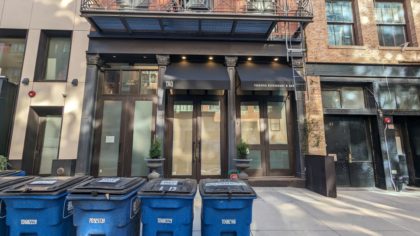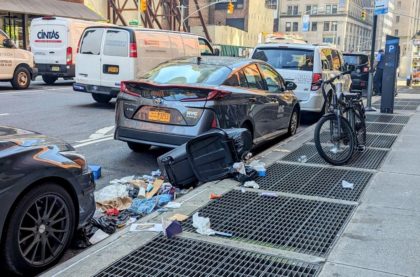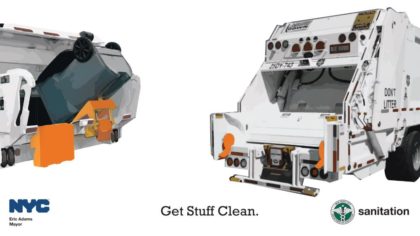Garbage containers will be required for smaller buildings by fall 2024
The city will now require all buildings with nine or fewer units — turns out that affects 95 percent of residential buildings in the city — to put their trash in containers, or “containerize” their trash, on the sidewalk starting fall 2024. No more bags on the sidewalk allowed.
New Yorkers “will be required to do what the rest of the world has done and place their waste not straight onto the sidewalk but into a secure wheelie bin,” said Sanitation Commissioner Jessica Tisch at the press conference yesterday. Next year, buildings will have to find their own bins; by summer 2026, the city will require the purchase of specific, official NYC bins.
The bins will be designed, built and sold by a vendor in the near future; Sanitation is releasing an RFP for the concession now. They will be designed for rat resistance, aesthetics, compatibility with mechanized collection (see the illustration below) and ease of use for DSNY employees.
The commissioner said that DSNY will retrofit trucks so DOS employees do not have to toss the trash bags into the bins. The bins will be sold, they hope, for about $50.
I know I am a broken record here on how much better life is in Copenhagen, but it’s true that the rest of the world does use containers — and it makes a lot more sense. (Someone tell me how they deal with trash in Mexico City.) It is way less gross.
What I don’t get is where these containers will go when NOT at the curb. In front of buildings, like Brooklyn? Or in basements? Deputy Commissioner Meera Joshi said this was also about reclaiming the sidewalks for public use. “For far too long we have used our precious sidewalk space for trash,” she noted. But how will the containers use the space better than the trash bags? They will look tidier, yes, but will they take up less space?
As if July, all food-related businesses — restaurants, caterers, grocery stores, delis and bodegas — are required to containerize their waste. Other commercial businesses are required to put their trash out later — after 8p — or containerize their trash if they put it out earlier. That’s the former Lekka Burger’s containers set up on Warren Street, above, and the bins for Sushi of Gari on Reade.
The plan for buildings with 10 or more units is not fully defined, but while bins for smaller buildings can go on the sidewalk, containers for the largest buildings will go on the street. This on-street container approach is being piloted on 10 residential blocks and at 14 schools in Hamilton Heights.
Official NYC bins will also be available for recycling and compostable material in the near future. In fact, the bins will be coming out in all colors and sizes, the commissioner said.


















This sounds great on paper, but the practicality for many smaller condos/coops is storage space for storing these trash cans. If the buildings have no storage in the basement or safe means to bring up the trash cans on trash nights how are they supposed to store them?
I hope this helps. The trash problem in the city is out of control. Athough just as important is to address the problem at source, by reducing food waste, converting to minimal and (where feasible) biodegradable packaging, etc.
Agreed!!
I agree with Scott. We are a small Coop (4 units) without a Super, just a sidewalk-cleaning Porter, and storage of bins in the basements will only attract the rats inside and encourage residents to store trash in the basement (instead of holding in their apartments until trash day). These containers will get nasty, quickly. We will have to hire someone to do what we used to do responsibly by ourselves.
A very unwelcome development if you are a New York City rat. And finally a city law that favors large buildings. Don’t even get me started on Local Law 11. But I digress. I’m fully in support of this program conceptually. Let’s see how the details play out and whether they roll back these requirements as officials get recycled over the next year :)
I haven’t seen a sanitation sweep cleaner in years. Why? I have seen cars hogging up the streets with placards in our area. The building owners are responsible for cleaning the sidewalks and 18 inches from the edge of the sidewalk into the street. Over thirty years ago we had bins and we replaced them with plastic bags. Plastic bags were a cleaner solution but not great for the environment. Now we are required to have plastic bins that many small buildings have no space for and will require maintenance. Yes, we will have to wash those plastic bins too. There is a cost for maintenance and our Coop/Condo or rents will be affected by the cost of maintenance.
Actually I was recently thinking about this very question: Why no street cleaning in the area, with alternate side parking etc.? I have never seen a street cleaning machine in the neighborhood. At least not in our part of Tribeca. Whereas in the Village area, it was a regular twice a week thing (years ago it was three times a week).
The street cleaners come around to most every street, twice a week. I know because I park on the street! The dining sheds have made it more challenging, but they still make laps.
It is worth reading the “Future of Trash” report to see (1) the potential of shared containers in parking lanes and (2) how DSNY is pushing back against shared containers in a parking lane for medium density areas like Tribeca.
https://www.nyc.gov/assets/dsny/site/resources/reports/future-of-trash
Here is the potential for shared containerization:
“DSNY determined through careful analysis that containerization is viable citywide for 89% of New York City streets with residential properties, comprising 77% of the City’s total residential waste output. All 89% of residential street sections can be containerized by eliminating up to 10% of current parking spaces citywide.”
“80% of the City’s residential street sections can have a viable containerization solution without any changes to frequency. However, 9% of street sections (representing 20% of residential waste) require an increase of up to two times current collection frequency to achieve viability. The remaining 11% of residential streets produce an outsized volume of waste relative to available street area – a function primarily of density –and therefore no containerization model is currently viable, even with aggressive collection frequency increases. Within the 11%, streets may also not be viable for containerization due to other demands on the streetscape (e.g., bike lanes, bus lanes, loading zones, or throughways) or if streets are too narrow to accommodate shared containers on the curb.”
That 11% includes areas like Financial District.
Here are the reasons DSNY’s report pushed against shared containerization:
“Most global cities that have mechanized trash collection through large, above-ground containerization systems required of New York City’s high-density areas do not have substantial snowfall. Cities that do have to contend with snow fall, such as Amsterdam or Zurich, employ an underground container system that limits the impact of weather. […]
“Snow is navigable for individual bins. For example, Toronto encourages residents to place individual bins next to snowbanks instead of behind them, and asks that residents shovel out space and ensure a clear path from the bins to the road. […]
“DSNY’s analysis found that, of the approximately 1.5 million parking spaces on residential streets, a citywide shared container program would account for a 10% reduction in parking on residential streets citywide, and up to 18% in a single community district. Not all neighborhoods would see a repurposing of parking spaces, as the use of shared on-street containers is not appropriate for single-family and low-density street sections; […]
“The trucks and staffing levels are set based on the historical precedent of a set level of service days for residents. Frequency of collection is based on a variety of factors, including the volume of waste generated, environmental impact of collection, and cost. Currently, collection frequency for refuse is either two or three times per week, while recycling (both metal/glass/plastic and paper streams) is once per week. Organics collection frequency is planned to mirror recycling frequency at once per week when it is rolled out to each borough through the end of 2024. […]
“Cities that have rolled out shared containers generally collect trash daily, as often as twice per day. […]
“In New York City, current frequency levels would require an unreasonable number of shared containers on high-density residential streets. Changing collection frequency would require a short-term inflation of staffing and fleet to accommodate the additional service level until residential behavior changes to flatten the setout volume across days of collection. […]
“Containerization requires a fleet that is compatible with the selected shared containers. Compatibility hinges on whether bins are stationary or wheeled and, if stationary, how containers are loaded into trucks. There are two primary considerations: would DSNY need a new collection truck and, if so, which truck model is optimal?
“Stationary shared containers can be serviced by an automatic side loading (ASL) or a hoist truck, each with costs and benefits; DSNY’s strongly preferred model is the ASL over the hoist truck. NYCHA is planning to pilot a hoist truck at off-street locations; however, this model presents safety risks when used on-street, with shared containers suspended above cars and pedestrians, and many City streets cannot accommodate the requisite 20-foot overhead clearance.
“Neither the ASL nor the hoist truck are currently available at scale in the U.S., and the ones manufactured in small numbers are not built to service a dense urban environment. The process to design, test, and manufacture the fleet needed for scaled shared stationary containers in New York City would take a minimum of three years and significant capital investments to complete. […]
“While containerization is standard practice in Europe, no major city in North America uses shared stationary containers at scale: Practically, this means that North America does not currently have access to fleet and bin manufacturing that is widely available in Europe.”
Great article! I wonder what buildings without any front garden space are supposed to do? Just leave the containers on the curb? And if they do have one and use the space (as a decorative garden or an outdoor sitting area, for example), would they want to keep trash containers there?
I think a larger shared container would be more optimal and would leave a smaller footprint on the sidewalk. Additionally, it could take a space of one parking spot and serve multiple smaller buildings on the block.
The current proposal as I understand it will put additional financial burden on the homeowners by having to hire someone to move bins to the street and pick them up the day after.